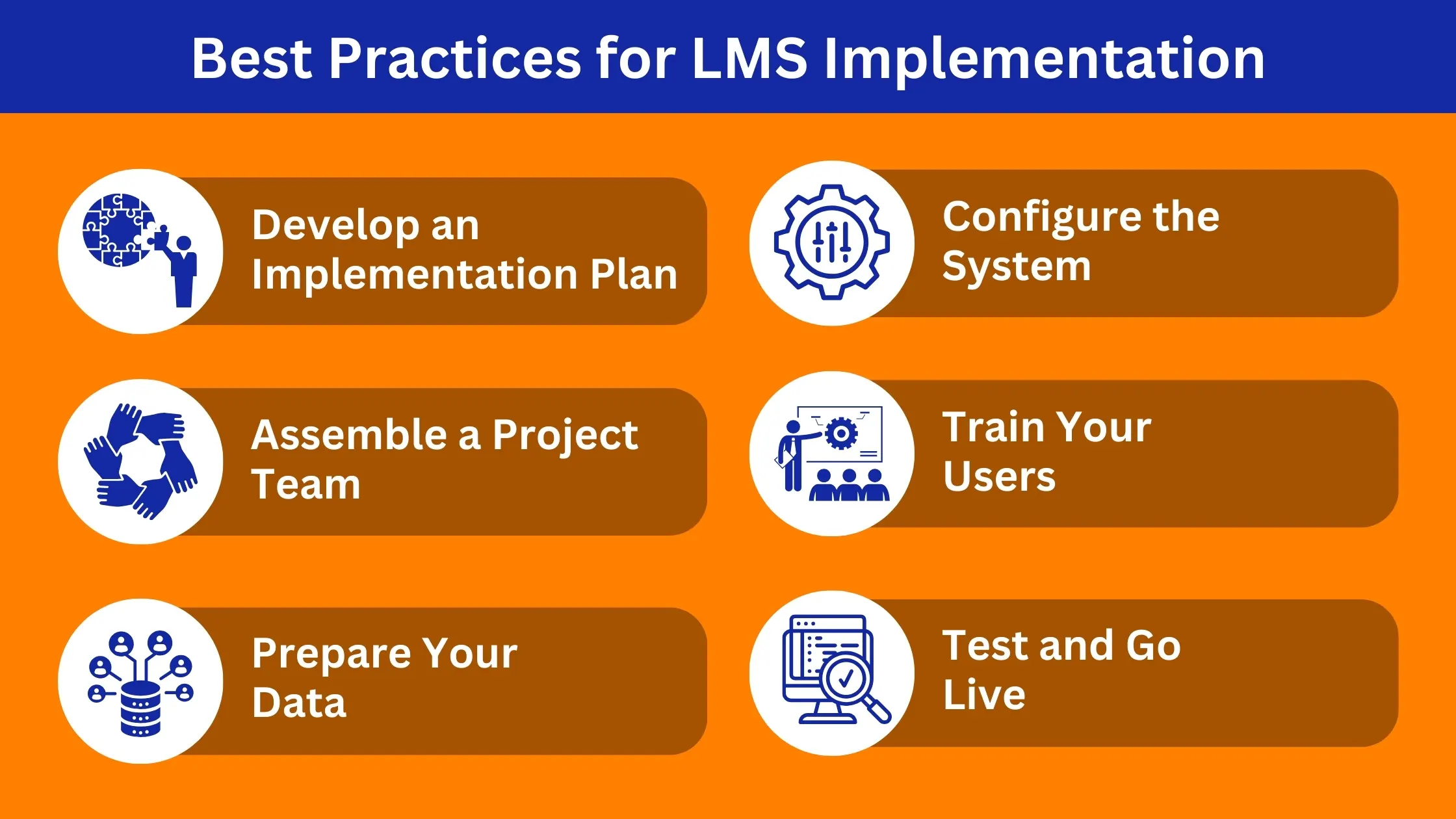In this guide, we’ll walk you through the process of selecting and implementing an LMS for compliance training. We’ll cover everything from understanding the role of an LMS in compliance training to evaluating different LMS options.
We’ll also touch on planning and executing a successful LMS implementation. Whether you are an HR professional, compliance officer, or training supervisor, this manual is designed for you.
Understanding the Role of an LMS for Compliance Training
An LMS serves as the backbone of an organization’s compliance training program. It allows for the centralized management of training content. Making it easier to deliver, track, and report on compliance training programs.
Here are some of the key roles an LMS plays in compliance training:
Content Delivery: An LMS allows for the efficient delivery of compliance training courses to employees. This can be in the form of online courses, webinars, or interactive modules.
Tracking and Reporting: An LMS tracks the progress of employees in their compliance training. It generates reports that provide insights into training completion, performance, and areas for improvement.
Certification Management: Many compliance training programs require employees to earn certifications. An LMS can manage these certifications, keeping track of who has been certified and when recertification is due.
Compliance Regulations: An LMS can help ensure that your organization’s compliance training program meets industry regulations and standards. It can provide evidence of training completion and compliance for audits.
The Importance of Compliance Training in Organizations
Compliance training is a crucial part of any organization’s operations. It makes sure workers know and follow the laws, regulations, and internal policies that apply to their job functions.
One of the primary benefits of compliance training is risk mitigation. Training employees on the rules and regulations they must follow helps organizations significantly reduce the risk of non-compliance. This can prevent costly fines, legal issues, and damage to the organization’s reputation. It can also lead to improved productivity and performance.
Compliance training also promotes a culture of integrity within the organization. It helps employees understand the ethical standards they are expected to uphold. This can help create a work environment that values honesty and transparency.
Conducting a Needs Analysis for LMS Selection
It’s important to conduct a needs analysis before picking an LMS. A needs analysis involves several steps. Start by identifying your key stakeholders. These could be HR professionals, compliance officers, training managers, or other decision-makers. Their input will be invaluable in determining the specific needs of your organization.
Now identify the specific compliance training needs of your organization. This could include the types of training required, the frequency of training, how often training needs to be updated, and the number of employees who need to be trained. You should also consider any specific industry regulations or training standards that your organization needs to comply with.
Once you have a clear understanding of your LMS selection criteria, you can begin to evaluate different LMS options. This will involve comparing the features, capabilities, and costs of various systems. The goal is to find an LMS that not only meets your current needs but can also scale as your organization grows and changes.
Aligning Organizational Goals with LMS Capabilities
Once you’ve identified your organization’s needs, the next step is to align them with the capabilities of potential LMSs. This involves understanding the features and functionalities of different systems and how they can support your compliance training goals.
For example, if one of your goals is to improve the tracking and reporting of compliance training, then you’ll want an LMS with robust analytics capabilities. This could include features like customizable reports, real-time tracking, and data visualization tools.
If your goal is to increase employee engagement with compliance training, then you might look for an LMS with gamification features. These could include points, badges, leaderboards, and other elements that make training more interactive and engaging.
It’s also important to consider the scalability of the LMS. If your organization plans to grow or expand its compliance training program, you’ll need an LMS that can scale with you. This might involve features like multi-language support, the ability to add new users easily, and the ability to handle large volumes of data.
Evaluating and Comparing LMS Options
After aligning your goals with potential LMS capabilities, the next step is to evaluate and compare different LMS options. This involves a detailed analysis of each system’s features, pricing, user reviews, and vendor reputation.
One effective way to do this is by creating a comparison chart or matrix. This tool can help you visualize the strengths and weaknesses of each LMS and make an informed decision. Here are some factors you might include in your comparison:
- Features and functionalities
- User interface and experience
- Pricing and licensing model
- Vendor reputation and customer service
- Integration capabilities
- Security and data protection measures
- Scalability and future-proofing
- Mobile Accessibility
- Customization options
- Reporting and analytics capabilities
Keep in mind that the best LMS for your organization is not necessarily the one with the most features or the lowest price tag. Instead, it’s the one that best meets your specific needs and goals for your compliance training.
In addition to your analysis, consider seeking input from other stakeholders in your organization. This could include HR professionals, IT staff, and the end-users of the LMS. Their perspectives can provide valuable insights into the practicality and usability of different systems.
The Significance of User Experience in LMS Selection
When selecting a compliance-focused LMS, user experience (UX) should be a top priority. A system that is difficult to navigate or understand can hinder learning and engagement. This could reduce the effectiveness of your training program. While a system with a strong UX can increase engagement and improve learning outcomes. Making your compliance training program more successful.
The best LMS platforms are intuitive and user-friendly. They make it easy for learners to access and complete their training, track their progress, and engage with the content. They also provide administrators with simple tools for managing courses, users, and reports.
Consider the needs and technical skills of your users when evaluating the UX of an LMS. A system that is perfect for tech-savvy users might be overwhelming for those with less experience. Similarly, a system designed for a small team might not scale well for a large organization.
In addition to the system’s interface, consider the quality of its customer support. Good support can greatly enhance the user experience, especially during the implementation phase and whenever issues arise.
Planning for LMS Implementation: Steps and Best Practices

A good LMS implementation lives or dies according to its strategic launch plan and by actively monitoring user engagement.
Implementing a new LMS is a significant undertaking. It requires careful planning and coordination to ensure a smooth transition and successful outcomes. Here are some steps and best practices to guide you through the process:
Develop an Implementation Plan: Start by outlining the steps, timelines, and responsibilities for the implementation process. This plan should include key milestones, such as system setup, data migration, user training, and go-live date.
Assemble a Project Team: Your project team should include representatives from all stakeholder groups, including IT, HR, training, and end-users. This team will be responsible for managing the implementation process and ensuring that the system meets the needs of all users.
Prepare Your Data: Before you can migrate your data to the new system, you’ll need to clean and organize it. This might involve removing outdated information, standardizing data formats, and resolving any inconsistencies.
Configure the System: Next, set up the system according to your organization’s needs. This includes configuring user roles and permissions, setting up courses and learning paths, and customizing the interface.
Train Your Users: Before the system goes live, provide training to all users. This should cover how to navigate the system, complete training, and use any relevant features. It’s also a good idea to provide ongoing support and resources for users after the system is launched.
Test and Go Live: Finally, conduct thorough testing to ensure the system is working as expected. Once you’re confident that everything is in order, you can go live with the system.
Training and Supporting Staff During LMS Rollout
The success of an LMS rollout largely depends on how well your staff can use the system. Therefore, training and support are crucial during this phase.
Start by identifying the different user groups within your organization. These might include administrators, trainers, managers, and learners. Each group will have different needs and require different levels of training.
For administrators and trainers, provide in-depth training on how to manage the system. This includes creating and assigning courses, tracking progress, and generating reports. They should also be trained in troubleshooting common issues and providing support to other users.
For managers, focus on how to monitor their team’s progress and use the system’s reporting features. They should also understand the importance of compliance training and how the LMS supports it.
For learners, the training should be simple and straightforward. Show them how to log in, access their courses, and track their progress. Make sure they understand how to use the system’s features and where to go for help.
Finally, establish a support system for users. This could be a dedicated helpdesk, a self-service portal, or a team of super users. The goal is to ensure that users can get help when they need it. Reducing frustration and encouraging continued use of the system.
Encouraging User Adoption and Engagement
User adoption and engagement are key to the success of your LMS. If your staff doesn’t use the system or only uses it reluctantly, you won’t see the benefits of your investment.
Start by communicating the benefits of the system to your staff. Explain how it will make their jobs easier, improve their skills, and help the organization meet its compliance goals. Make sure they understand what’s in it for them.
Next, make the system easy to use. A user-friendly interface, intuitive navigation, and clear instructions can go a long way in encouraging usage. Also, consider the needs of your diverse workforce. For example, ensure the system is accessible to people with disabilities and supports multiple languages if needed.
Gamification can also boost engagement. This could include points, badges, leaderboards, or other game-like elements. These can make training more fun and motivate users to complete their courses.
Provide ongoing support and encouragement. Recognize and reward those who are using the system effectively. Also, be responsive to feedback and make improvements as needed. This shows that you value your staff’s input and are committed to making the system work for them.
Remember, user adoption and engagement don’t happen overnight. It takes time, effort, and patience. But with the right strategies, you can create a positive learning culture and get the most out of your LMS.
Evaluating LMS Success: Metrics and Feedback
Once your LMS is up and running, it’s important to evaluate its success. This involves looking at metrics and gathering feedback from users.
Start by identifying key performance indicators (KPIs). These could include course completion rates, test scores, time spent on training, and user engagement levels. These metrics can give you a sense of how well your staff is learning and how engaged they are with the system.
Next, gather feedback from your users. This could be through surveys, interviews, or informal conversations. Ask them what they like about the system, what they don’t like, and what improvements they would like to see. This feedback can provide valuable insights into how the system is working and where improvements can be made.
Also, consider the impact of the LMS on your compliance goals. Are you seeing a decrease in compliance issues? Are audits going more smoothly? These outcomes can indicate the effectiveness of your LMS.
Remember, evaluation is an ongoing process. Regularly review your metrics, gather feedback, and make adjustments as needed. This will help ensure your LMS continues to meet your needs and contributes to compliance training success.
Common Pitfalls in LMS Selection and Implementation and How to Avoid Them
Selecting and implementing an LMS can be a complex process. There are several common pitfalls that organizations often fall into. By being aware of these, you can take steps to avoid them.
One common pitfall is not clearly defining your needs before starting the selection process. This can lead to choosing an LMS that doesn’t align with your organization’s goals or needs. To avoid this, conduct a thorough needs analysis before you start looking at different systems.
Another pitfall is not involving key stakeholders in the selection process. This can result in a lack of buy-in and resistance to the new system. To avoid this, make sure to involve representatives from all relevant departments in the selection process.
A third pitfall is underestimating the time and resources needed for implementation. This can lead to delays and cost overruns. To avoid this, develop a detailed implementation plan and budget, and be sure to account for training and support needs.
Many organizations fail to plan for ongoing maintenance and updates. This can lead to the system becoming outdated and less effective over time. To avoid this, make sure to include plans for regular updates and maintenance in your implementation plan.
Conclusion: The Future of Compliance Training with LMS
As we look to the future, the role of LMS in compliance training is set to become even more critical. With the increasing complexity of regulations and the need for continuous training, an LMS can provide a scalable and efficient solution.
One key trend is the increasing use of artificial intelligence and machine learning in LMS. These technologies can help personalize the learning experience and provide more effective training. They can also help identify training gaps and provide insights for improving compliance programs.
Another trend is the increasing importance of mobile learning. With the rise of remote work and the need for flexible training options, mobile-friendly LMS will become a necessity. This will allow employees to access training materials anytime, anywhere, and on any device.
In addition, we can expect to see more integration between LMS and other systems. This will allow for more efficient data management and reporting and will make it easier to track compliance across the organization.









